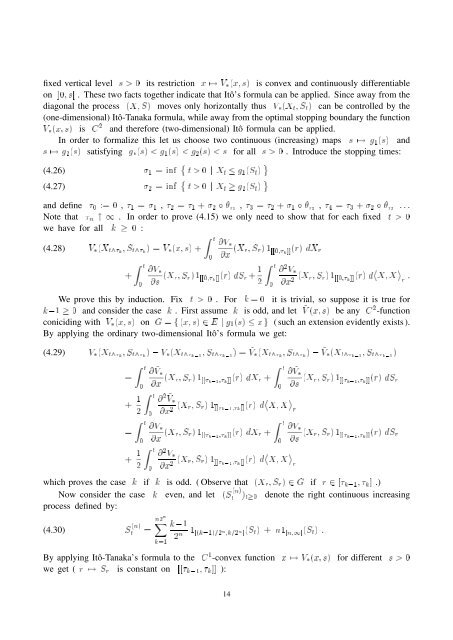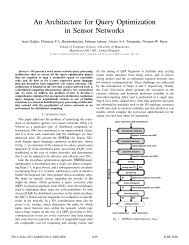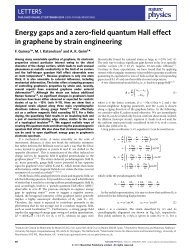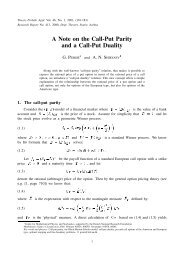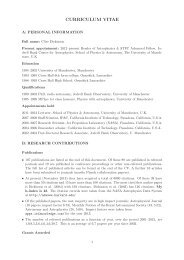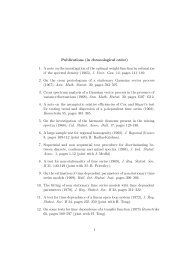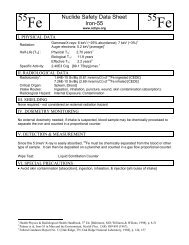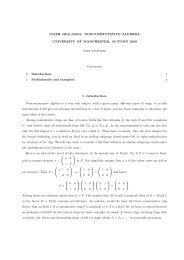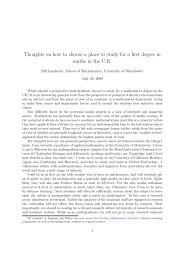inequality for geometric Brownian motion
inequality for geometric Brownian motion
inequality for geometric Brownian motion
Create successful ePaper yourself
Turn your PDF publications into a flip-book with our unique Google optimized e-Paper software.
fixed vertical level s > 0 its restriction x 7! V3(x; s) is convex and continuously differentiableon ]0; s[ . These two facts together indicate that Itô’s <strong>for</strong>mula can be applied. Since away from thediagonal the process (X; S) moves only horizontally thus V3(X t ; S t ) can be controlled by the(one-dimensional) Itô-Tanaka <strong>for</strong>mula, while away from the optimal stopping boundary the functionV3(x; s) is C 2and there<strong>for</strong>e (two-dimensional) Itˆo <strong>for</strong>mula can be applied.In order to <strong>for</strong>malize this let us choose two continuous (increasing) maps s 7! g 1 (s) ands 7! g 2 (s) satisfying g3(s) < g 1 (s) < g 2 (s) < s <strong>for</strong> all s > 0 . Introduce the stopping times:(4.26) 1 = inf8t > 0 j X t g 1 (S t )9(4.27) 2 = inf8t > 0 j X t g 2 (S t )9and define 0 := 0 , 1 = 1 , 2 = 1 + 2 1 , 3 = 2 + 1 2 , 4 = 3 + 2 3 . . .Note that n " 1 . In order to prove (4.15) we only need to show that <strong>for</strong> each fixed t > 0we have <strong>for</strong> all k 0 :(4.28) V3(X t^ k; S t^ k) = V3(x; s) +Zt+Zt0@V3@s (X r; S r )1 [[0;k ]](r) dS r + 1 20@V3@x (X r; S r ) 1 [[0;k]](r) dX rZt0@ 2 V3@x 2 (X r; S r )1 [[0;k ]](r) d X; Xr .We prove this by induction. Fix t > 0 . For k = 0 it is trivial, so suppose it is true <strong>for</strong>k01 0 and consider the case k . First assume k is odd, and let ~V (x; s) be any C 2 -functionconiciding with V3(x; s) on G = f (x; s) 2 E j g 1 (s) xg ( such an extension evidently exists ).By applying the ordinary two-dimensional Itˆo’s <strong>for</strong>mula we get:(4.29) V3(X t^ k; S t^ k) 0 V3(X t^ k01; S t^ k01) = ~V3(X t^ k; S t^ k) 0 ~V3(X t^ k01; S t^ k01)=Zt0+ 1 2Zt0=Zt0+ 1 2Zt@ ~V3@x (X r; S r ) 1 ]]k01; k ]](r) dX r +Zt@ 2 ~V3@x 2 (X r; S r ) 1 ]]k01; k ]](r) dX; Xr@V3@x (X r; S r ) 1 ]]k01; k ]](r) dX r +Zt0@ 2 V3@x 2 (X r; S r ) 1 ]]k01; k ]](r) dX; Xr00@ ~V3@s (X r; S r ) 1 ]]k01; k ]](r) dS r@V3@s (X r; S r ) 1 ]]k01; k ]](r) dS rwhich proves the case k if k is odd. ( Observe that (X r ; S r ) 2 G if r 2 [ k01; k ] .)Now consider the case k even, and let (S (n)t ) t0 denote the right continuous increasingprocess defined by:(4.30) S (n)t =Xn2 nk=1k012 n 1 [(k01)=2 n ;k=2 n [(S t ) + n1 [n;1[(S t ) .By applying Itô-Tanaka’s <strong>for</strong>mula to the C 1 -convex function x 7! V3(x; s) <strong>for</strong> different s > 0we get ( r 7! S r is constant on [[ k01; k ]] ):14


